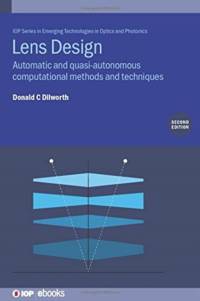Om Lens Design (Second Edition)
This second edition of Lens Design: Automatic and quasi-autonomous computational methods and techniques shows how these new tools can design systems in minutes that would have required weeks or months of labor using older methods.
Powerful search routines that can quickly produce excellent designs starting with plane-parallel plates are described. The principles are explained, and data files are provided so the user can duplicate these systems and learn how to use the new software to solve unexpected problems should they occur. Automatic substitution of real glass types for a glass model, and automatic matching to the testplates of a selected vendor are fully explained with examples.
Key Features
Discusses the pros and cons of traditional design tools and the role of aberration theory todayExplains the topology of the lens design landscape and why there are many different solutionsShows how to quickly achieve many potential solutions and how to select a preferred solutionDescribes tools for modifying a lens form by automatically inserting or deleting elementsLists a variety of tips and ideas that resulted from 50 years of experience
Visa mer

